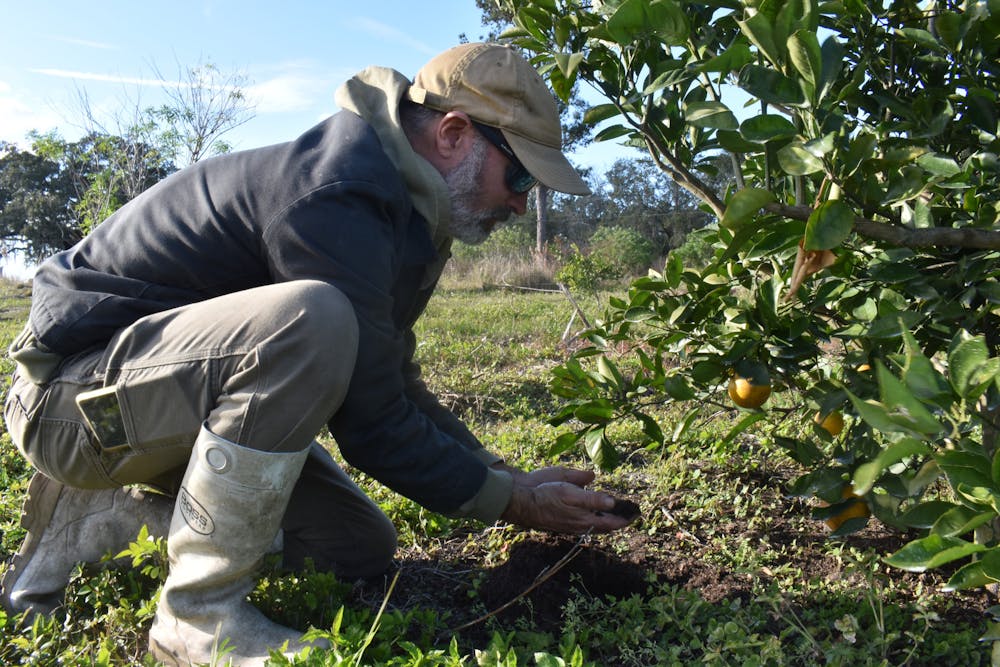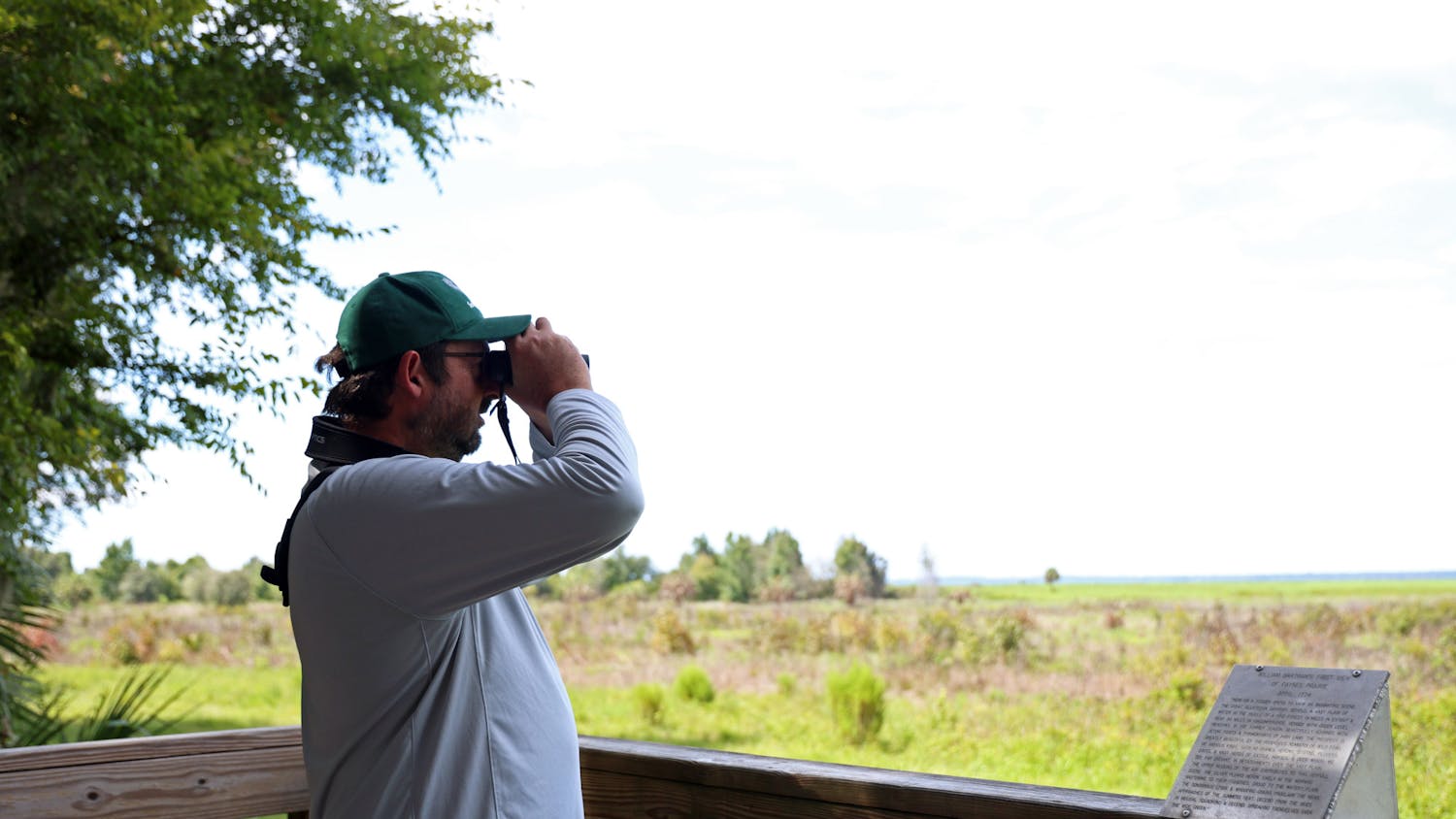In his camouflage golf cart, John Bitter drives slowly through a graveyard of citrus trees.
The trees’ trunks are knobby, the branches spindly and bare. Some fell to a hard frost, while others were suffocated by citrus greening disease.
Bitter is the co-founder of Frog Song Organics, a small family farm in Hawthorne, Florida. Frog Song has two to three hundred citrus trees, which Bitter says he’s worked hard to maintain through citrus greening.
“[Citrus greening] is definitely here,” Bitter said. “It’s all around Florida.”
Huanglongbing, or citrus greening disease, has ravaged the citrus industry in Florida over the past two decades. Since the disease was first detected in 2005, it has reduced citrus production by over 75% and cost the industry billions of dollars in lost revenue.
Researchers have studied the disease for decades but have yet to find a lasting solution to citrus greening.
Bitter has his own methods of controlling the disease: using plant extracts instead of pesticides, pig manure instead of chemical fertilizer and chickens instead of weed killer.
For Frog Song’s groves, the organic approach works. While Bitter still loses a few trees to greening each year, he said most of his citrus crop remains productive.
Many growers across the state haven’t been so lucky. Since HLB, the cost of growing citrus has doubled, making it too expensive for small farmers to profit.
“It’s a losing game business-wise to run a conventional grove,” Bitter said.
The culprit behind citrus greening is brown and unassuming, about the size of a speck of dirt, called the Asian citrus psyllid.
William Kern, a UF entomology professor, said the psyllid is an invasive insect and the primary carrier of HLB. While both HLB and the psyllid originated in Asia, it’s unclear exactly how both made their way to Florida, he said.
Psyllids feed on citrus trees, Kern said, where they introduce HLB through regurgitation. The disease then infects a tree’s vascular system, effectively strangling it to death.
Trees contaminated with citrus greening often produce discolored fruit that tastes bitter and dry, Kern said. Additional symptoms include weak root systems, stunted growth and yellowing leaves. The disease is incurable, and an infected tree usually dies after three to five years.
A new invasive insect establishes itself in Florida every month, Kern said, but most invading pests have a limited impact on the state. The psyllid, however, has proved to be a lasting problem.
“That’s probably one of our number one most destructive insects,” Kern added.
Before the spread of HLB, Florida was the citrus empire. The state consistently produced over 200 million boxes of citrus every year, cementing its role as the nation’s “orange state.” Once citrus greening began to ravage the industry, production steadily declined.
Yet the citrus industry’s 2022-2023 season has been the worst in recent memory, said Florida Commissioner of Agriculture Wilton Simpson. Florida produced a mere 18 million boxes of citrus, the lowest in almost a century. Additionally, the struggles of citrus greening were only compounded by Hurricane Ian in 2022, which Simpson said wiped out groves in South Florida.
However, Simpson believes Florida is turning a corner. Florida’s 2023-2024 budget included $65 million to bolster the citrus industry, a trend Simpson expects to continue. The money funds research to combat citrus greening as well as planting new trees, he said.
“Over the next three to five years, I think we’re gonna continue to expand,” Simpson said. “Things are gonna get better in the citrus industry.”
At the UF/IFAS Citrus Research and Education Center, experts are working to find new ways to combat citrus greening. Center director Michael Rogers said one of the center’s main goals is to help citrus growers stay in business.
In the face of citrus greening, many growers either switch to more lucrative crops or sell their farms entirely, Rogers said.
“You’ve seen people just give up,” he said.
While citrus greening is incurable, the UF/IFAS center has found ways to make diseased trees productive for longer, Rogers said.
By providing smaller doses of water and fertilizer more frequently, citrus growers can improve the trees’ ability to absorb nutrients. In essence, growers have to spoon-feed their trees.
Helping existing farmers is a critical priority for the UF/IFAS center, but its long-term goal is to find a way to end citrus greening altogether. The center is looking at multiple methods involving genetics, Rogers said.
One promising avenue is breeding new varieties of citrus that are more tolerant to HLB, he said. Another potential solution is editing the genes of existing varieties to make trees resistant to the disease.
Either way, Rogers said he’s hopeful the center will be able to find a lasting solution to the disease.
“It’s a long-term process to get those trees in the hands of growers so they can start making money,” he said.
UF/IFAS scientists also plan to create a $2 million Crop Transformation Center, with the main objective of finding citrus varieties that are resistant to citrus greening.
At Frog Song Organics, Bitter circles a blood-orange tree looking for ripe fruit. He talks about his citrus trees with the affection someone might use with a pet, beaming with pride when he cuts open one of his oranges.
Through his 13 years in the industry, Bitter has tested which varieties of citrus work on his farm. He has decided to invest less in certain breeds that are more susceptible to citrus greening, such as the Valencia orange.
Even if he has to change the products he grows or how he grows them, Bitter said he’s determined to stay adaptable on his farm in order to succeed.
“North Florida is such a unique environment,” he said. “There’s not a whole lot of places like this.”
Contact Kylie Williams at kyliewilliams@alligator.org. Follow her on X @KylieWilliams99.
Kylie Williams is the Spring 2025 Digital Managing Editor and a third-year journalism major. She has also worked as the enterprise editor and the environmental enterprise reporter. In her free time, she can be found reading, baking or watching reality TV with her cat.






